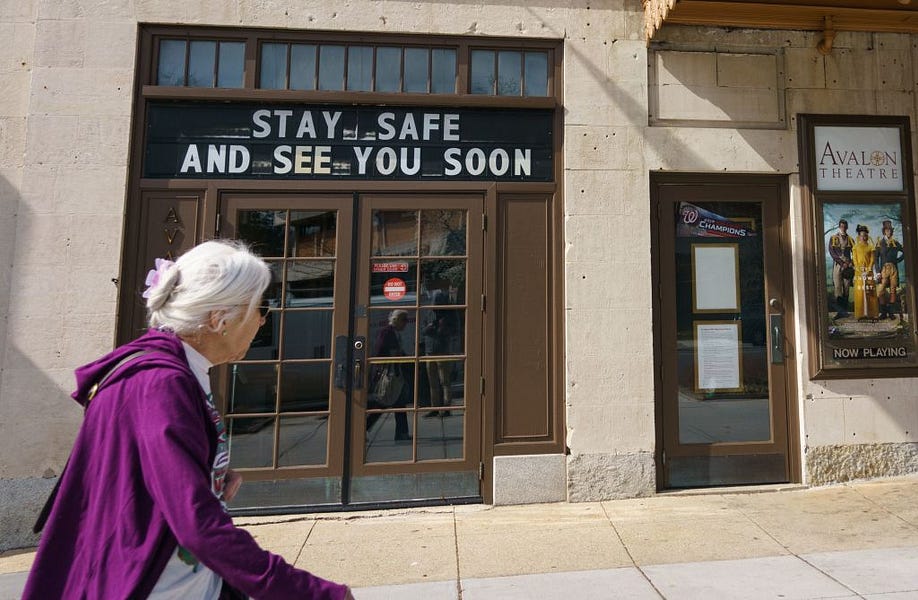There is an old, outdated adage about America. Perhaps you’ve heard it. “All politics is local.” That’s no longer close to true. With the rise of negative polarization, the increase in the power of the presidency, and the limited number of truly competitive congressional races—not to mention the ongoing losses of local news outlets that cover local politics—it’s now clear that all politics is national. We interpret virtually every race at every level for its impact on the race for president. Combine this new trend with the old tradition of turning to presidents in times of national crisis, and all eyes are on Donald Trump.
And so, when he tweets things like this:
Or says things like this:
Americans understandably believe that Trump can issue orders that will transform our lives, reopen restaurants, reopen churches, and put America back to work. But that’s false. All politics may now be national, but all power is not, and American states control the status of businesses in their jurisdiction, not the president.
I explained the distinction between state and federal power over public health at length in a piece on The Dispatch home page last week. I don’t want to repeat the entire tutorial, but the summary of the American constitutional structure is that the federal government is a government of enumerated powers. It has only the power granted it by the Constitution. States, by contrast, possess a sovereign “police power,” an inherent authority that is limited by state constitutions and applicable federal law.
That police power has long extended to public health. Going all the way back to 1824, the Supreme Court has noted that states have the power to impose “quarantine laws” and “health laws of every description.” In theory, Congress may use its power under the Constitution’s Commerce Clause to grant the president additional authority over commerce during a public health crisis, but it has not done that. Thus, the true executive authority of state commerce rests with governors.
To put things very simply,the White House announced new guidelines c on March 16 with the headline “15 Days to Slow the Spread.” If, on March 31, Trump declares “mission accomplished” and tweets that America should be open for business again, each and every governor could simply say no. They could go their own way.
Of course that’s not what would happen. With some notable exceptions, red-state governors—especially those in states with few COVID-19 cases—would find themselves under immense political pressure to lift restrictions. That pressure would likely be paired with calls to follow Florida’s lead and restrict travel from more-infected regions:
Blue-state governors—especially those who govern states with large urban populations where the virus is hitting far harder than in rural America—by contrast would likely defy the president. They may impose their own travel restrictions from red states, claiming that that red states’ increased openness increased the chance of viral spread.
Moreover, the extraordinary economic power of America’s big blue states means that there is no healthy American economy without a healthy California or a healthy New York and New England.
Isn’t it easy to see how our national solidarity in the face of a viral threat can easily transform into rising fury and resentment between competing American regions?
We may well see both the blessings and the curses of federalism. The blessing is clear—state governors are best-equipped to assess conditions in their states and act accordingly. They have powers at their disposal that the federal government does not possess. The curse may also become clear, with red and blue states pitted against each other in a patchwork of public health measures that may make us more aware of state boundaries than any time since the Civil War.
This brings us back to Trump. During a Fox News interview today he indicated that he wanted the country “opened up” by Easter (April 12). If this is a date pegged as acceptably safe by public health officials, Americans need to know the basis for the target. What data leads them to believe that governors can open up their states without incurring unacceptable risk?
If there is no such data, then Trump may have created an unnecessary problem. He may have pushed us down the road toward recriminations and further division without actually hastening an economic recovery. Millions of Americans—especially those in the areas least affected by the virus—may now start a countdown to normal life. If governors relax their restrictions under presidential pressure even though the health risk is still too high, then our nation risks the worst of both worlds—a deep recession and a public health disaster.
Why? These two tweets, from former Trump FDA Commissioner Scott Gottlieb, tell the tale:
Gottlieb is making an essential point. Human behavior is not entirely dependent on government directives. While many millions of Americans may leap from their homes at the earliest legal opportunity, many millions will not—especially if the disease is prevalent in their communities.
And if they do go out, they may retreat just as quickly if they see friends and neighbors fall ill with a disease that often punches even young and healthy people far harder than the flu. Just because Trump says “go,” that does not mean that a sufficient number of Americans will heed his call. And they may well be right to retain their caution.
Did the next shoe drop?
Just as I started drafting this newsletter, I received a press release indicating that the first COVID-19 case was diagnosed in Syria. If you look at the Johns Hopkins coronavirus database, you’ll see that for now the disease is located overwhelmingly in the world’s most advanced nations. That makes a degree of sense—after all, it’s the jet-setters who took it out of China’s borders. But it’s truly alarming to consider what may happen if and when the disease hits nations with still-developing health infrastructure, combined with intense crowding in growing cities. If the disease can bring Italy to its knees, what will it do to a nation like Syria? What can it do in refugee camps?
The argument I pray we have.
I’ve got one last COVID-19 thought—while social media is sometimes full of pictures of people who aren’t social distancing, any quick trip outside the house demonstrates that the country is shut down to a degree that I’ve never seen. Last Friday, I traveled with my oldest kids back to Knoxville to empty out my son’s University of Tennessee dorm room.
We arrived downtown almost precisely at 5 p.m. The streets were nearly deserted. When we walked on campus to clean out his room (by appointment) we saw fewerw than 10 people in two hours. There are exceptions, and those exceptions are dangerous, but we shouldn’t minimize the fact that Americans by the tens of millions are making exactly the sacrifices asked of them. It makes a difference.
I hope and pray that our present (and very real) sacrifice makes such a difference that sooner rather than later American politics is consumed with a food fight over whether our nation overreacted to the virus. I hope and pray that our ultimate destiny looks nothing like Italy’s. As I stated during Meet the Press this Sunday, our national history is full of examples where America bungled its early responses to crises before it righted the ship.
In our polarized times, the sign of our national success will likely be a national argument. It’s the argument I want to have.
One last thing …
There are those who believe our national isolation will make us withdraw farther away from each other even after the danger is largely passed. I disagree. The lack of sports alone has created an almost-physical pain in some of us. Expect to see incredible exuberance once the games begin. In the meantime—in a spirit of pure vengeance and spite—I want to retaliate against my misguided friends and readers who like Duke basketball.
CBS replayed the legendary 1992 regional final against my beloved Kentucky Wildcats. You might remember the game—Christian Laettner hit the game-winning shot after a long pass from Kentucky’s baseline. It was a dreadful moment. But that’s not the final chapter in the Duke/Kentucky rivalry. There was another contest and another epic comeback. Let’s pick up the action with about five minutes to go in the 1998 South Regional final. Good times. Very, very good times:
Photograph of the Avalon Theatre in Washington, D.C., by Photo by Mandel Ngan/AFP via Getty Images.








Please note that we at The Dispatch hold ourselves, our work, and our commenters to a higher standard than other places on the internet. We welcome comments that foster genuine debate or discussion—including comments critical of us or our work—but responses that include ad hominem attacks on fellow Dispatch members or are intended to stoke fear and anger may be moderated.
You are currently using a limited time guest pass and do not have access to commenting. Consider subscribing to join the conversation.
With your membership, you only have the ability to comment on The Morning Dispatch articles. Consider upgrading to join the conversation everywhere.